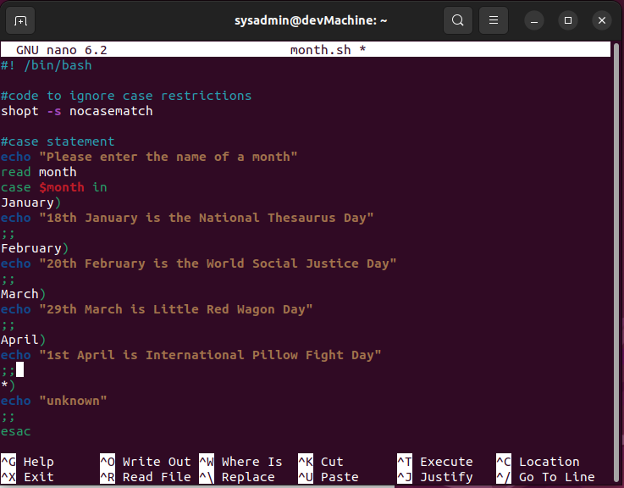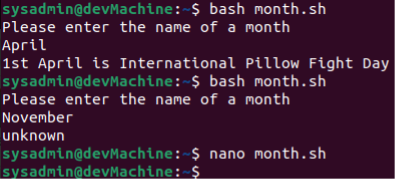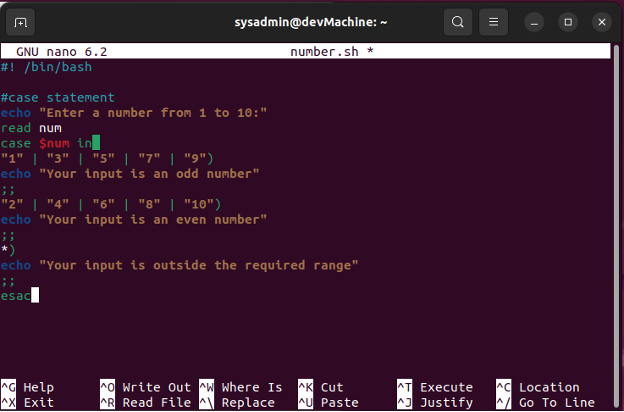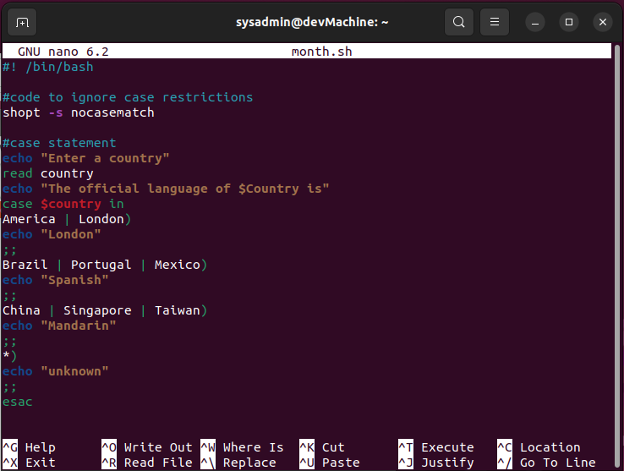How to Use the Bash Case Statement
The case statement is generally used in Bash when you have multiple choices to select from. Using it instead of nested if-else statements helps keep your Bash scripts easier to read and maintain.
The Bash case statement has been designed similar to the case statement from JavaScript and C. Unlike the switch statement from C, the Bash case statement stops searching for other matches as soon as it finds one and completes the statements that are written for the pattern.
In this guide, we will explain how you can use the Bash case statement using two examples and some scenarios in Ubuntu 22.04.
Syntax of the Case Statement
If you want to understand how to use the case statement, you need to understand the syntax. It looks like this:
pattern1)
commands
;;
pattern2)
commands
;;
patternN)
commands
;;
*)
commands
;;
esac
Let’s break it down:
- It’s imperative that you open up the statement with the “case” keyword and close it out with the “esac” keyword.
- We use the closing bracket “)” to terminate a pattern.
- Patterns containing commands are known as clauses and they end with “;;”.
- You can use an “*” (asterisk) to define a default case.
- When the case command matches the input variable with the defined patterns, upon a match, the corresponding set of commands code are executed up to the double semicolons.
- If you want the same command to be executed for multiple patterns, you can use the pipe operator to put the patterns together as such:
pattern1| pattern2)
commands
;;
pattern3| pattern4)
commands
;;
Now, let’s take a look at a couple of examples to understand this syntax better.
Holidays in a Month
For our first example, let’s write a script that takes a month as input from the user and responds with an international holiday that falls in the month. The “shopt -s nocasematch” command allows your script to ignore the case of the input and match it with the cases irrespective of that.
#code to ignore case restrictions
shopt -s nocasematch
#case statement
echo "Please enter the name of a month"
read month
case $month in
January)
echo " 18th January is the National Thesaurus Day"
;;
February)
echo " 20th February is the World Social Justice Day"
;;
March)
echo "29th March is Little Red Wagon Day."
;;
April)
echo "1st April is International Pillow Fight Day"
;;
*)
echo "Couldn’t find any holiday in your specified month”
esac

In this script, we take the name of a month from the user and store it in a variable named “month”. Then, using the case statement, we compare the input with some pre-selected months and then display the respective holiday. You can see that if the code doesn’t find any match in the defined cases, it then have an echo outside the cases to display another message. And after that, we close the case code structure with the “esac” keyword.
Save the script file and exit out of the nano editor. Run the script using the following command:

You can see that the code responded with the relevant holiday for the input that was catered to with cases, and responded with unknown when the input was out of range from the programmed cases.
The Official Language of a Country
Let’s write a script that utilizes the composite cases. For this example, let’s write a script that takes a country and prints the official language of that country.
#code to ignore case restrictions
shopt -s nocasematch
#case statement
echo "Enter a country: "
read country
echo "The official language of $COUNTRY is "
case $COUNTRY in
America | London)
echo "English"
;;
Brazil | Portugal | Mexico)
echo "Spanish"
;;
China | Singapore | Taiwan)
echo "Mandarin"
;;
*)
echo "unknown"
;;
esac
Case Statement with Integers
You can also create the cases where you have to match the input with integers as well. Let’s create a script that takes the input from the users in the range of 1-10, and then displays if the number is even or odd.
#case statement
echo "Enter a number from 1 to 10: "
read num
case $num in
“1” | “3” | “5” | “7” | “9”)
echo “Your input is an odd number”
;;
“2” | “4” | “6” | “8” | “10”)
echo “Your input is an even number”
;;
*)
echo “Your input is outside the required range”
;;
esac

Running this script gives you the following output:

You can test with the other numbers as well.
Case Statement with For Loop
You can use the case statement within the for-loops if you want to check multiple input values against your set cases. Let’s illustrate this case by writing a script that goes through all of the files in the current directory and display their file type.
#for every file in the current directory
for File in $(ls)
do
#extract the file extension
Extension=${File##*.}
case “$Extension” in
sh)
echo “Bash Script File: $File”
;;
png)
echo “PNG Image File: $File”
;;
txt)
echo “Text File: $File”
;;
*)
echo “Unknown File”
;;
Esac
done

Running this script goes through every file in the current active directory and displays it along with its file type (only the cases we specified). As you can see, when running this script that we only have one file in the current directory, it displays that along with the extension.
Conclusion
Going back to your older code and figuring out what line does can be a very cumbersome task, especially if it was written by somebody else. Adding to it is even harder. Using the case statement in your Bash scripts can make it very easy for you to keep it readable through the easy syntax.
As demonstrated with the examples, you can use it with strings, multiple strings, integers, and for loops, among many others. You can even handle the exit codes for your program with case statements. It’s very versatile.
If you face any issues using the case statement, feel free to engage us and we’ll gladly help you out.
Source: linuxhint.com



